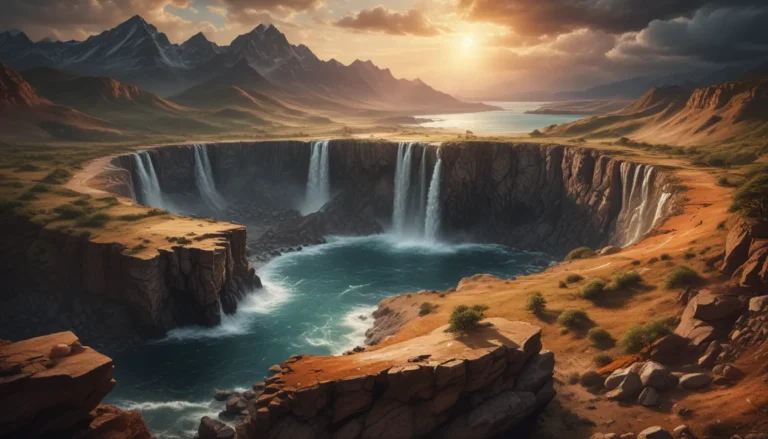A Note About Images: The images used in our articles are for illustration purposes only and may not exactly match the content. They are meant to engage readers, but the text should be relied upon for accurate information.
Nunataks, the isolated peaks that defy icy landscapes and offer a glimpse into Earth’s history, are truly remarkable geological formations. These rugged beauties serve as natural shelters for plant and animal life, connecting continents, and serving as beacons of scientific research. In this article, we will delve into 11 astonishing facts about nunataks that will leave you in awe of their wonder and significance. Join us on a journey of exploration as we uncover the secrets of these incredible formations.
The Meaning of Nunatak
Originating from the Inuit language, the term “nunatak” translates to “lonely peak,” perfectly capturing the essence of these geological formations. These isolated peaks emerge amidst vast ice fields and glaciers, showcasing their resilience and beauty.
Nunatak’s Formation Process
During the Ice Age, nunataks originated from topographic irregularities that prevented ice from covering the entire landscape. These elevated peaks managed to stand tall above the surrounding ice sheets, creating striking natural landmarks.
Existence in Antarctica
Antarctica, with its icy expanse, is home to numerous nunataks that proudly defy the frozen sea and piercing cold. These isolated peaks offer a glimpse into the dynamic nature of polar regions and the wonders they hold.
A Shelter for Flora and Fauna
Surprisingly, nunataks provide refuge for plant and animal life in inhospitable polar regions. These isolated peaks create microclimates that support a more favorable environment for life to thrive, showcasing the adaptability of nature in extreme conditions.
Connecting the Continents
Nunataks act as rare natural bridges that connect different continents, serving as remnants of ancient land bridges that once linked now-separate landmasses. These geological wonders offer insights into Earth’s history and the movements of continents over time.
Environmental Indicators
Scientists study nunataks as important environmental indicators, analyzing the flora and fauna present on these isolated peaks to gain insights into past climate conditions. Studying nunataks helps researchers track environmental changes over time and understand the impact of climate change on polar regions.
A Haven for Research
Nunataks play a crucial role in scientific research, particularly in the field of glaciology. Researchers study these natural formations to understand the dynamics of glacial movement, ice melting, and the effects of climate change on polar regions. Nunataks offer valuable data for studying Earth’s changing climate patterns.
Nunataks’ Significance in Mountaineering
Adventure seekers and mountaineers are drawn to nunataks as formidable climbing challenges. Scaling these isolated peaks requires physical prowess and a deep respect for the harsh, unforgiving environment they thrive in, making them sought-after destinations for those seeking thrilling mountaineering experiences.
Melting in a Changing Climate
With the planet warming, many nunataks are experiencing the effects of melting ice and receding glaciers, posing an ecological threat to the unique ecosystems nurtured by these isolated peaks. The impact of climate change on nunataks highlights the pressing need for conservation efforts to protect these fragile environments.
Nunataks as Natural Landmarks
Embracing the beauty and uniqueness of nunataks, they serve as natural landmarks and points of interest for those exploring the polar regions. These isolated peaks offer breathtaking vistas of their surroundings, leaving visitors in awe of the awe-inspiring landscapes and the wonders of nature.
The Allure of Nunataks
The 11 astonishing facts about nunataks explored in this article shed light on the captivating world of these geological wonders. From their formation to their ecological significance, nunataks continue to intrigue scientists, explorers, and nature lovers alike. With their resilience, beauty, and connection to Earth’s history, nunataks remind us of the incredible power and wonders that our planet holds.
Conclusion
In conclusion, nunataks offer a unique glimpse into Earth’s history and the resilience of life in extreme conditions. These isolated peaks showcase the beauty of nature and serve as important ecological islands supporting diverse flora and fauna. Exploring nunataks is a thrilling adventure that provides opportunities to witness breathtaking landscapes and uncover hidden treasures. Whether you’re a nature enthusiast, an adventure seeker, or a geology lover, visiting nunataks is sure to leave you awe-inspired. Start planning your journey to these astonishing landforms and delve into the mysteries they hold. Let the beauty and grandeur of nunataks captivate and inspire you.
FAQs
Q: What is a Nunatak?
A: A nunatak is an exposed peak or ridge of a mountain that protrudes above an ice sheet or glacier, creating a striking natural landmark in polar regions.
Q: How are Nunataks formed?
A: Nunataks are formed through glacial erosion, where the movement and scraping of glaciers erode softer rocks, leaving behind resistant peaks.
Q: Where can Nunataks be found?
A: Nunataks can be found in regions with large ice sheets or glaciers, such as Antarctica, Greenland, and other polar regions, as well as in mountainous areas covered by glaciers.
Q: Are there any living organisms on Nunataks?
A: Yes, nunataks host a variety of plant and animal life that have adapted to the extreme environment, showcasing nature’s resilience.
Q: Do Nunataks have any significance in climate change studies?
A: Yes, nunataks play a crucial role in studying the effects of climate change, providing valuable data on glacial movement and ice melting in polar regions.
Immerse yourself in the wonders of nunataks and discover the beauty and significance of these geological marvels. Embark on a journey of exploration and let the awe-inspiring landscapes of nunataks inspire you to appreciate the wonders of our planet.






